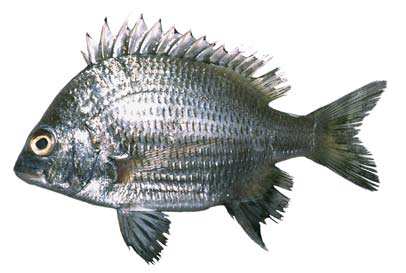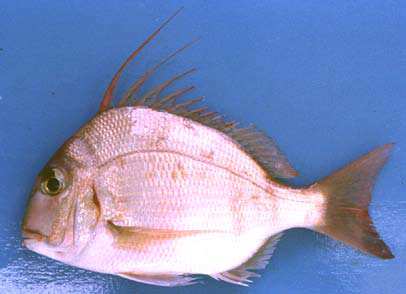SPARIDAE
Seabreams or Porgies
By Yukio Iwatsuki
 Acanthopagrus berda |
 Argyrops spinifer |
|
Body more or less oblong, more or less deep and compressed. Jaw teeth well developed, differentiated in to either conical (canine like) or flattened (incisor like), and often round, molarlike. Dorsal fin single with X-XIII spines and 9-17 soft rays, the spinous and soft portions not separated by a notch, anterior spines sometimes elongate or filamentous; anal fin with III spines and 7 to 15 soft rays; pectoral fins usually long and pointed; an axillary scale at their base; caudal fin more or less deeply emarginate or forked. Scales cycloid or weakly ctenoid; a single continuous lateral line extending backward to base of caudal fin. Color: overall color highly variable, from pinkish or reddish to yellowish or grayish, often with silvery or golden reflections, often with dark or colored spots, stripes or bars. Similar families occurring in the area. Haemulidae: edge of preopercle serrate; suborbital space scaled; at 2 conspicuous pores beneath chin; also never molar teeth. Lutjanidae: edge of preopercle usually serrate, and often excavated to accommodate a bony knob; also never molar or incisor-like teeth; palate usually toothed (except in Aphareus). Lobotidae: edge of preopercle strongly toothed; never molar teeth; dorsal, anal and caudal fins rounded, appearing as a single trilobed fin (Tripletails). Lethrinidae: posterior tip of maxilla overlapping premaxilla; cheek and preopercular flange scaleless (but scales present on some genera); 8 to 11 soft dorsal-fin rays (9 to 17 in Sparidae); incisor-like teeth never present. Remarks. Seabreams inhabit tropical and temperate coastal waters. They are demersal inhabitants of the continental shelf and the slope. Occasionally they are found in estuaries used as nurseries. Hermaphroditism is widespread in this family. Most seabreams are excellent foodfish and are of notable commercial importance. Maximum length 100 cm. This family needs an urgent review of worldwide. |

|
|